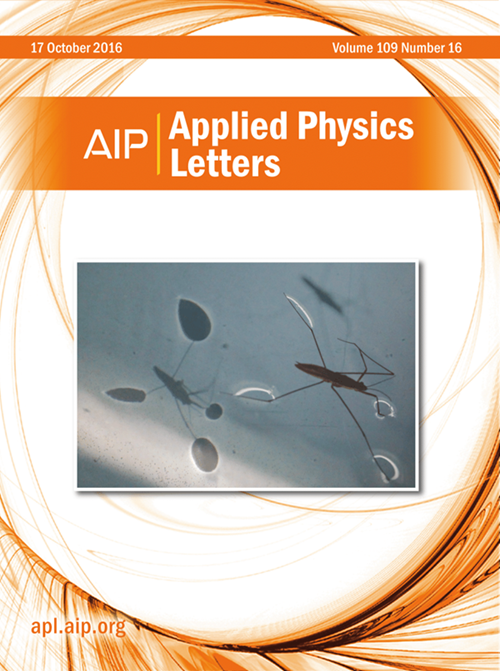Single monolayer ferromagnetic perovskite SrRuO3 with high conductivity and strong ferromagnetism
IF 3.6
2区 物理与天体物理
Q2 PHYSICS, APPLIED
引用次数: 0
Abstract
Achieving robust ferromagnetism and high conductivity in atomically thin oxide materials is critical for advancing spintronic technologies. Here, we report the growth of a highly conductive and ferromagnetic single monolayer SrRuO3 (SRO) having a high Curie temperature of ∼ 154 K on DyScO3 (110) substrates. The SrTiO3 capping layer effectively suppresses surface reactions, which typically hinder ferromagnetism in atomically thin films. X-ray absorption spectroscopy and x-ray magnetic circular dichroism measurements revealed strong orbital hybridization between Ru 4d and O 2p orbitals in the SRO monolayer, which contributes to the enhancement of the conductivity and ferromagnetic ordering of both the Ru 4d and O 2p orbitals. The resistivity of the single monolayer SRO is comparable to that of the bulk SRO. This study highlights the potential of monolayer SRO as a platform for two-dimensional magnetic oxide systems, offering opportunities for the exploration of spintronic devices and quantum transport phenomena.具有高导电性和强铁磁性的单层铁磁钙钛矿SrRuO3
在原子薄的氧化材料中实现强大的铁磁性和高导电性是推进自旋电子技术的关键。在这里,我们报道了在DyScO3(110)衬底上生长出具有高居里温度(~ 154 K)的高导电和铁磁性单层SrRuO3 (SRO)。SrTiO3盖层有效地抑制了表面反应,而表面反应通常会阻碍原子薄膜的铁磁性。x射线吸收光谱和x射线磁圆二色性测量结果表明,在SRO单层中Ru 4d和o2p轨道之间存在强烈的轨道杂化,这有助于增强Ru 4d和o2p轨道的电导率和铁磁有序性。单层SRO的电阻率与块状SRO相当。这项研究强调了单层SRO作为二维磁性氧化物系统平台的潜力,为探索自旋电子器件和量子输运现象提供了机会。
本文章由计算机程序翻译,如有差异,请以英文原文为准。
求助全文
约1分钟内获得全文
求助全文
来源期刊

Applied Physics Letters
物理-物理:应用
CiteScore
6.40
自引率
10.00%
发文量
1821
审稿时长
1.6 months
期刊介绍:
Applied Physics Letters (APL) features concise, up-to-date reports on significant new findings in applied physics. Emphasizing rapid dissemination of key data and new physical insights, APL offers prompt publication of new experimental and theoretical papers reporting applications of physics phenomena to all branches of science, engineering, and modern technology.
In addition to regular articles, the journal also publishes invited Fast Track, Perspectives, and in-depth Editorials which report on cutting-edge areas in applied physics.
APL Perspectives are forward-looking invited letters which highlight recent developments or discoveries. Emphasis is placed on very recent developments, potentially disruptive technologies, open questions and possible solutions. They also include a mini-roadmap detailing where the community should direct efforts in order for the phenomena to be viable for application and the challenges associated with meeting that performance threshold. Perspectives are characterized by personal viewpoints and opinions of recognized experts in the field.
Fast Track articles are invited original research articles that report results that are particularly novel and important or provide a significant advancement in an emerging field. Because of the urgency and scientific importance of the work, the peer review process is accelerated. If, during the review process, it becomes apparent that the paper does not meet the Fast Track criterion, it is returned to a normal track.
 求助内容:
求助内容: 应助结果提醒方式:
应助结果提醒方式:


